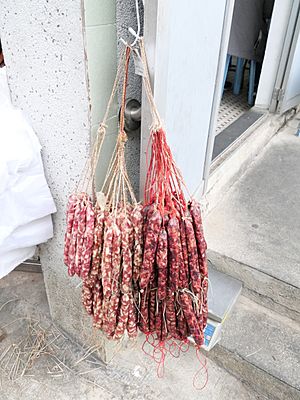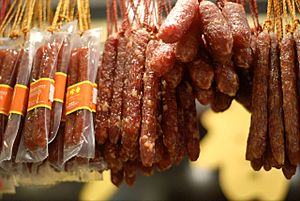Chinese sausage facts for kids

Dried Chinese sausages
|
|
| Alternative names | lap cheong, lap chong |
|---|---|
| Type | Sausage |
| Place of origin | China |
| Main ingredients | fresh pork or liver |
| Chinese sausage | |||||||||||||||||||||
|---|---|---|---|---|---|---|---|---|---|---|---|---|---|---|---|---|---|---|---|---|---|
| preserved sausage | |||||||||||||||||||||
| Traditional Chinese | 臘腸 | ||||||||||||||||||||
| Simplified Chinese | 腊肠 | ||||||||||||||||||||
| Literal meaning | preserved sausage | ||||||||||||||||||||
|
|||||||||||||||||||||
| liver sausage | |||||||||||||||||||||
| Traditional Chinese | 膶腸 | ||||||||||||||||||||
| Simplified Chinese | 膶肠 | ||||||||||||||||||||
| Literal meaning | liver sausage | ||||||||||||||||||||
|
|||||||||||||||||||||
| Vietnamese name | |||||||||||||||||||||
| Vietnamese | lạp xưởng | ||||||||||||||||||||
| Thai name | |||||||||||||||||||||
| Thai | กุนเชียง [kūn t͡ɕʰīa̯ŋ] | ||||||||||||||||||||
| RTGS | kun chiang | ||||||||||||||||||||
Chinese sausage is a special type of sausage that comes from China. Many people know the southern Chinese version by its Cantonese name, lap cheong (or lap chong) (simplified Chinese: 腊肠; traditional Chinese: 臘腸; Mandarin Pinyin: làcháng; Jyutping: laap6 coeng2; Cantonese Yale: laahp chéung). These sausages are often dried and have a unique flavor.
Contents
Exploring Different Kinds of Chinese Sausages
There are many kinds of Chinese sausages. Some are made mostly from lean meat, while others have more fat. They can be made from fresh pork, or even from duck or pig livers. Sausages made with liver usually look darker. Recently, some countries have even started making Chinese sausages from chicken.
Here are some popular types:
- Lap cheong (Cantonese, or simplified Chinese: 腊肠; traditional Chinese: 臘腸; Mandarin Pinyin: làcháng; Jyutping: laap6 coeng2; Cantonese Yale: laahp chéung) is a hard, dried sausage. It's usually made from pork and pork fat. This sausage is often smoked, a little sweet, and seasoned with rose water, rice wine, and soy sauce.
- Yun chang (simplified Chinese: 膶肠; traditional Chinese: 膶腸; Mandarin Pinyin: rùn cháng; Jyutping: jeon2 coeng2; Cantonese Yale: yéun chéung) is a type of sausage made using duck liver.
- Xiang chang (simplified Chinese: 香肠; traditional Chinese: 香腸; Mandarin Pinyin: xiāng cháng; Jyutping: hoeng1 coeng2; Cantonese Yale: hēung chéung) is a fresh, plump sausage. It has chunky pieces of pork and fat. This sausage usually tastes quite sweet.
- Nuomi chang (simplified Chinese: 糯米肠; traditional Chinese: 糯米腸; Mandarin Pinyin: nuòmǐ cháng; Jyutping: no6 mai5 coeng2; Cantonese Yale: noh máih chéung) is a white sausage. It's filled with glutinous rice and flavorings. It's then steamed or boiled until it's cooked.
- Xue chang (simplified Chinese: 血肠; traditional Chinese: 血腸; Mandarin Pinyin: xuě cháng; Jyutping: hyut3 coeng2; Cantonese Yale: hyut chéung) are Chinese sausages where blood is the main ingredient.
- Bairouxue chang (simplified Chinese: 白肉血肠; traditional Chinese: 白肉血腸; Mandarin Pinyin: báiròuxuě cháng; Jyutping: baak6 juk6 hyut3 coeng2; Cantonese Yale: baahk yuhk hyut chéung) is popular in northeast China. It has chopped meat mixed into the blood sausage.
- Guan chang (Chinese: 贯肠) is a long, red sausage made from fresh meat.
Chinese Sausages in Different Regions
Chinese sausage is a common ingredient in many dishes. You can find it in the southern Chinese provinces like Guangdong, Fujian, Jiangxi, Sichuan, and Hunan. It's also popular in Hong Kong and Taiwan.
For example, Sichuan sausage has red chili powder, Sichuan pepper powder, and Pixian bean sauce. These ingredients give it a special spicy flavor. Two common dishes that use Chinese sausage are fried rice and lo mai gai (糯米雞), which is a sticky rice dish. You can often find traditional, unpackaged sausages in wet markets.
Hongchang: A Special Smoked Sausage
In northeast China, especially in Harbin, there's a famous sausage called Hongchang (simplified Chinese: 红肠; traditional Chinese: 紅腸; pinyin: hóng cháng). This smoked red sausage is similar to Polish kielbasa. It has a coarse texture and more "European" flavors compared to other Chinese sausages.
Hongchang was first made in March 1909 by Lithuanian workers. They worked at a Russian-owned factory in Harbin. This Harbin-style sausage became very popular in China, especially in the northern areas. There's also a sweeter, dried version of Hongchang that is similar to southern Chinese sausages.
Chinese Sausages Around the World
Chinese sausage is enjoyed in many countries outside of China. It has become a part of local dishes in different places.
Vietnam
In Vietnamese, Chinese sausage is called lạp xưởng or lạp xường. It's used in many dishes, from simple omelets to main courses. Because the sausages are salty, people use them carefully with other ingredients to balance the taste. They are made from pork (lạp xưởng heo) or chicken (lạp xưởng gà). Chicken sausage has a leaner taste.
Myanmar
In Burmese, the sausage is called kyet u gyaung (chicken sausage) or wet u gyaung (pork sausage). Sausages made in Myanmar are often meatier and more compact. They are usually added to fried rice or fried vegetables, like cabbage.
Philippines
In the Philippines, Chinese sausage is used in some Chinese-Filipino dishes. One example is siopao bola-bola, a type of steamed bun. Sometimes, it's confused with a local sausage called Chorizo de Macao. This local sausage is not from China, but it uses star anise, which is a spice often found in Chinese cooking in the Philippines.
Taiwan
Taiwan also makes a similar sausage. However, they are usually not dried like Cantonese sausages. The fat and meat might be blended together, and more sugar is often used, making them sweeter. These sausages are usually made by local butchers and sold in markets or made at home. In Mandarin Chinese, this type of sausage is called xiangchang (香腸), which means "fragrant sausage."
Singapore
Singapore has created new types of Chinese sausages that are healthier. For example, you can find low-fat, low-sodium, and high-fiber Chinese sausages there.
Thailand
In Thai, Chinese sausage is called kun chiang (Thai: กุนเชียง). This name comes from its name in the Teochew dialect. It's used in many Chinese dishes by the large Thai Chinese community. It's also found in some Thai dishes, like yam kun chiang, which is a salad made with this sausage. Some Chinese sausages in Thailand are even made with snakehead fish.
Suriname
In Suriname, Chinese sausage is known by a Hakka Chinese word. It's spelled in different ways like fatjong or fachong. It's an ingredient in the dish moksi meti tyawmin, which is a mixed meat chow mein.
Other Places
You can usually find Chinese sausages in Asian supermarkets outside of Asia. They often come in vacuum-sealed packages. Some Chinese grocery stores also sell the unpackaged kinds. Many of these sausages are made locally. For example, in Canada, many Chinese sausages are made by companies in Vancouver and Toronto. Lap cheong is also very popular in Hawaii. This is because many Chinese people live there and have added it to their local food.
See also
 In Spanish: Salchicha china para niños
In Spanish: Salchicha china para niños






